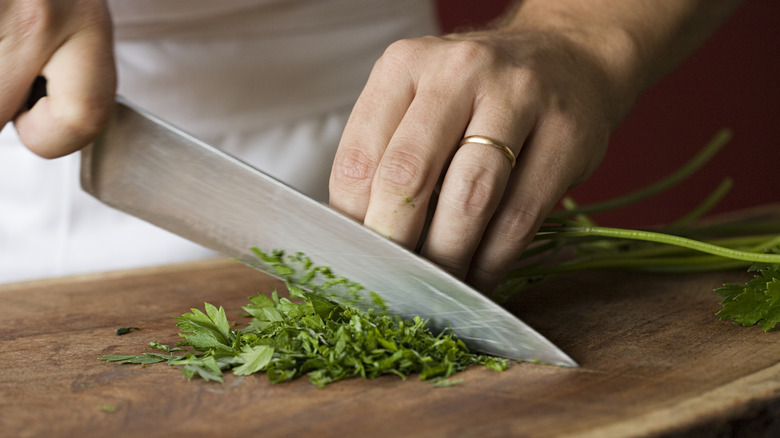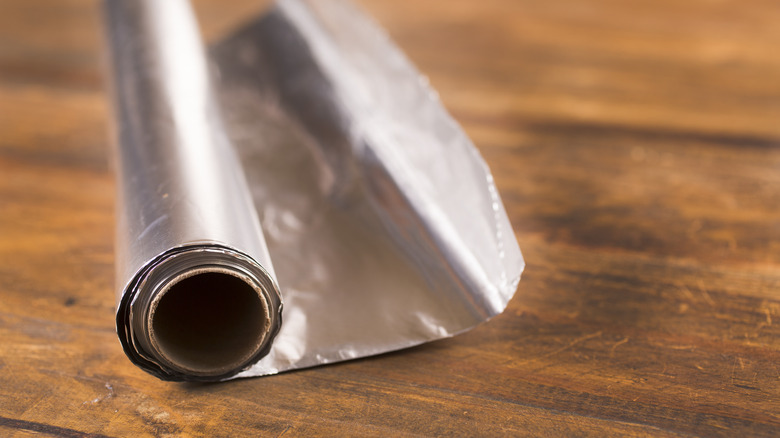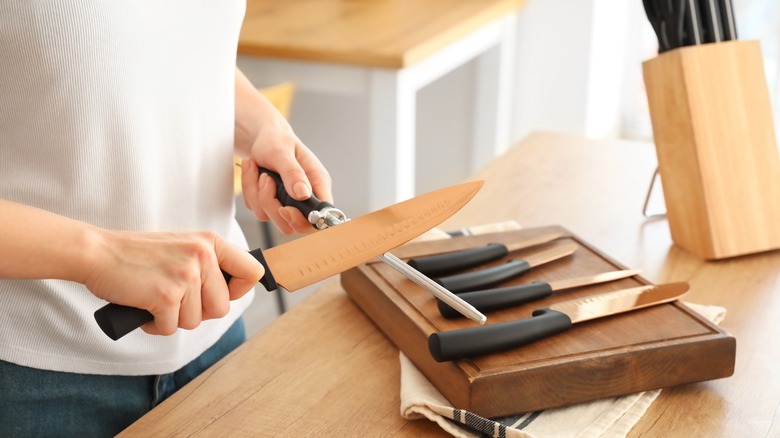Sharpen Your Dull Kitchen Knives With A Household Staple You Already Own
If you're the chef de cuisine in your household, you're likely aware of how frustrating dull knives can be when preparing a meal. Slicing through a tomato with a blunt knife is both tenuous and dangerous. Kitchen knives dull over time due to continuous friction against cutting surfaces like boards and countertops, and even animal bones or frozen foods can reduce the effectiveness of a knife. As a knife loses its sharpness, it requires more force to cut, making it prone to slipping and increasing the risk of accidents. Dull knives also lead to imprecise cuts, affecting the visual appeal of dishes and the texture of ingredients. Regular maintenance and proper sharpening are essential to keep kitchen knives in optimal condition for safe and effective food preparation. That being said, not everyone can afford professional knife sharpening, and even finding a physical store that sells a knife sharpener these days can be a hassle. Nevertheless, a roll of aluminum foil can serve as a makeshift knife sharpener to expedite your meal prep endeavors.
Aluminum's malleable nature allows users to create a makeshift abrasive surface quickly. While not as precise as dedicated sharpening tools, the foil provides a temporary solution for maintaining a reasonably sharp edge. This method is advantageous for its accessibility and convenience, allowing individuals to sharpen knives without specialized equipment. However, caution should be exercised to ensure safety when working with sharp utensils.
How to sharpen your knives using aluminum foil
Using aluminum foil is a makeshift method that can be used in a bind to quickly sharpen dull kitchen knives. Start by cutting a piece of aluminum foil, approximately 10-12 inches in length, and fold it several times to create a layered strip. This folded strip will serve as the abrasive surface for the sharpening process. Next, ensure that the knife blade is clean and dry to facilitate a smoother sharpening experience. Hold the folded aluminum foil strip securely in one hand and position the knife at a 20-degree angle against the foil with the other hand. Carefully glide the blade along the foil in a sweeping motion, applying light pressure. Repeat this process several times on both sides of the blade, alternating sides to maintain an even edge.
After sharpening, inspect the blade for any signs of nicks or irregularities. If necessary, repeat the process until the desired sharpness is achieved. Finally, thoroughly clean the knife to remove any metal particles or debris generated during the sharpening process. While using aluminum foil for knife sharpening is not as precise as professional sharpening tools, these steps, if executed with caution, can offer a temporary solution for maintaining a reasonably sharp kitchen knife. However, it's important to note that this method may not be suitable for all types of knives, and investing in proper sharpening tools for a more effective and safer outcome is better in the long run.
Cautions for using aluminum foil to sharpen knives
Using aluminum foil to sharpen your kitchen knives should be approached with caution and only as a last resort due to potential risks and limitations. While some individuals claim that the abrasiveness of aluminum foil can help to sharpen knives, it is essential to recognize the downsides. Aluminum foil is a relatively soft material, and using it as a sharpening tool may not provide the consistent and precise sharpening that a dedicated sharpening stone or honing rod can offer. Moreover, the foil can wear down quickly, leading to uneven sharpening and potential damage to the knife blade. Additionally, the process may generate metal shavings that can pose a safety hazard if not handled carefully. These small metal particles can end up in food or cause injuries if not properly cleaned up.
A safer alternative to using aluminum foil for knife sharpening is investing in proper sharpening tools. Dedicated sharpening stones, honing rods, or even electric knife sharpeners provide a more controlled and effective means of sharpening blades. Sharpening stones, for example, come in various grits, allowing users to gradually refine the edge of the knife with precision. Honing rods help maintain the sharpness of the blade between more intensive sharpening sessions. These tools are specifically designed for sharpening knives, and choosing the right tool for the job ensures a safer and more effective knife sharpening experience.


